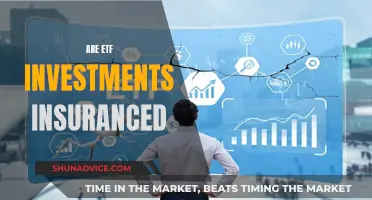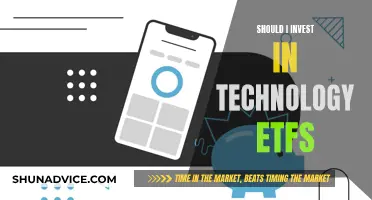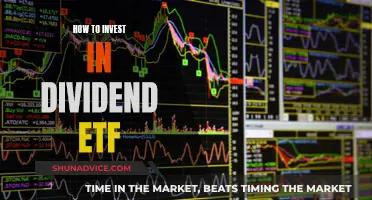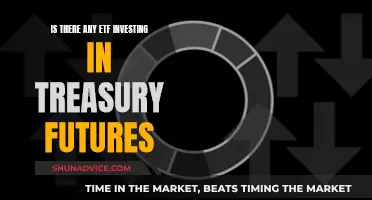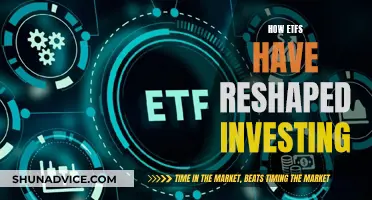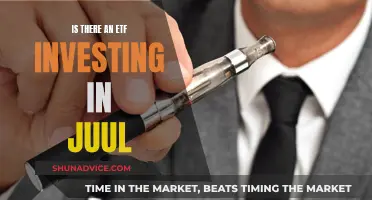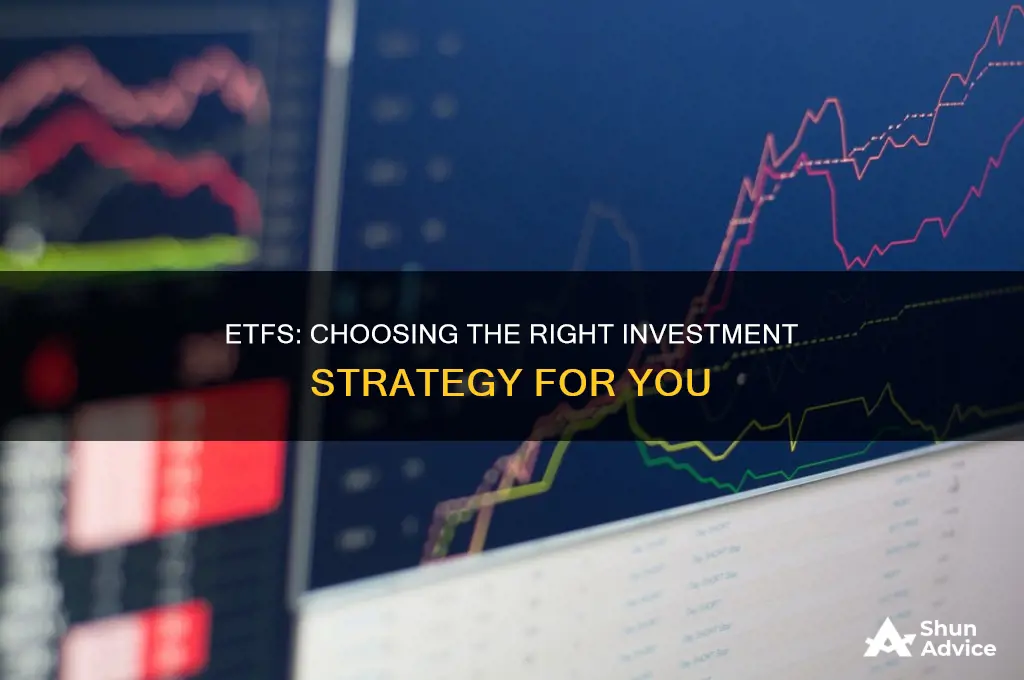
Exchange-traded funds (ETFs) are an appealing alternative to owning individual stocks. They are an easy way to begin investing and are fairly simple to understand. They can be an excellent entry point into the stock market for new investors as they are cheap and typically carry lower risk than individual stocks since a single fund holds a diversified collection of investments.
When investing in ETFs, there are several factors to consider. Firstly, it is important to assess the level of assets and trading activity of the ETF, as this indicates its liquidity. It is also crucial to understand the underlying index or asset class that the ETF is based on. Tracking error, market position, and the ETF's structure are other key considerations. Additionally, investors should evaluate the ETF's expense ratio, sustainability, replication method, income treatment, provider, fund currency, and domicile.
ETFs provide exposure to a broad range of opportunities, including specific sectors, international markets, and asset classes. They are also more liquid than mutual funds, making them attractive to investors.

Performance and tracking difference
When investing in ETFs, it is important to consider the performance and tracking difference of the fund.
Performance refers to how closely an ETF matches the index performance. While an ETF is closely aligned with the performance of the index it is tracking, they do not match exactly. This is due to several factors, such as the costs involved in managing an ETF. To assess the performance of an ETF, investors can compare how consistently the ETF tracks the index returns over time.
Tracking difference refers to the gap between an ETF's real-world return and an index's virtual return. A good ETF minimises the tracking difference, which theoretically equals the market return of the index minus the running costs of the ETF. To assess the tracking difference, investors can compare the overall returns of ETFs that follow the same index across the same time period.
When selecting an ETF, it is important to consider both performance and tracking difference to ensure that the ETF is closely aligned with the desired index and is delivering returns that meet the investor's expectations.
In addition to performance and tracking difference, there are several other factors that investors should consider when selecting an ETF, including the underlying index, structure, trading time, and costs.
Iran ETF: A Guide to Investing in Iran's Future
You may want to see also

Underlying index
When considering investing in an ETF, it is important to look at the underlying index or asset class on which the ETF is based. From a diversification perspective, it may be more beneficial to invest in an ETF based on a broad, widely followed index.
An index-based ETF aims to replicate the performance of the market or subset of the market that it is tracking, minus the fees. There are two basic types of indexes: those that track the overall market, such as the S&P 500 Index, and those that track a targeted subset of the market, such as small-cap growth stocks or large-cap value stocks. There are also indexes for bonds, commodities, and currencies.
It is important to note that index ETFs do not perfectly track the underlying index; there is usually some level of tracking error, which is the difference between the ETF market price and the net asset value of the fund. When selecting an ETF, it is crucial to assess fees, liquidity, and tracking error.
- Index Methodology: Most U.S.-listed equity ETFs are linked to indexes that use a market capitalization-weighting strategy. However, ETFs that utilise alternative weighting methodologies, such as equal-weighting or revenue-based weighting, have become increasingly popular.
- Depth of Holdings: The number of securities underlying an ETF can vary significantly, impacting the ETF's risk/return profile. A larger number of holdings does not necessarily indicate better diversification, as it depends on the weighting of each security within the ETF.
- Tracking Efficiency: While most ETFs aim to replicate the performance of their underlying index, there can be discrepancies. Tracking error measures the difference between an ETF and its underlying index, with smaller differences indicating a more efficient ETF.
- Tax Efficiency: ETFs generally offer more advantageous tax treatment compared to actively managed mutual funds due to their lower turnover and the nuances of the creation/redemption process. Examining the distribution history of an ETF can help identify potential red flags, such as frequent short-term capital gains distributions.
A Guide to Investing in ASX 200 ETFs
You may want to see also

ETF structure
The structure of an ETF determines how it tracks its target index and which assets the index can hold. This impacts the total cost, projected returns, and anticipated risk. There are two types of ETF structures: physical and synthetic.
Physical ETFs are the most common type. They track the target index by holding all or some of the underlying assets of the index. For example, an ETF that tracks the S&P 500 Index will consist of either all 500 companies in the index or a representative sample of that basket of stocks.
Synthetic ETFs, on the other hand, do not invest in assets directly. Instead, they hold a series of agreements with a third party, often an investment bank, who promises to pay back an agreed level of return when the tracked asset reaches a certain price. Synthetic ETFs are ideal for exposure to hard-to-access assets like commodities such as crude oil. They often offer higher potential returns than buying stocks or other vehicles that involve directly holding the asset, but they also come with greater risk, including potential exposure to counterparty risk.
When choosing between the two structures, consider the client's investment goals. Physical ETFs are more widely available and usually have lower risk. Synthetic ETFs can provide greater access to different assets with potentially higher returns but often carry more associated risk.
Investing in the Future: 5G ETF Opportunities
You may want to see also

Trading time
When investing in ETFs, it's important to consider the trading time, which refers to the timing of buying and selling ETFs in the market. Here are some key considerations regarding trading time:
Liquidity and Volatility
ETFs trade on exchanges, and their prices fluctuate throughout the trading day, just like stocks. They offer more liquidity than mutual funds, as they can be bought and sold at any time during the trading hours. However, it's worth noting that markets tend to be more volatile near the open and close of the trading day. Therefore, it is generally recommended to trade ETFs after the first 20 minutes and before the last 20 minutes of the trading day to avoid extreme volatility.
Trading Activity and Volume
Trading volume, or liquidity, is a crucial indicator of an ETF's performance and liquidity. Generally, higher trading volume indicates higher liquidity and tighter bid-ask spreads. When assessing an ETF's trading activity, it's essential to consider the underlying index or asset class it tracks. Broad market indices, for instance, are ideal for diversification.
Timing Strategies
When deciding on the timing of your trades, you can consider various strategies, such as market orders, limit orders, stop orders, and stop-limit orders. A market order is executed immediately at the best available price. A limit order is placed to buy or sell an ETF at a specified price or better. A stop order is triggered when the ETF reaches a specified price and is then executed as a market order. A stop-limit order combines the features of a stop order and a limit order, waiting for a specified price to be reached and then executing as a limit order.
Costs
When trading ETFs, it's essential to be mindful of the costs involved. There are two main types of costs associated with ETFs: transaction fees and the fund's expense ratio. Transaction fees occur when you buy or sell an ETF, and the expense ratio is an annual fee calculated as a percentage of your investment. Additionally, consider the bid-offer spread, which is the difference between the buying and selling price of an ETF and varies depending on its liquidity.
Tax Implications
Finally, don't forget to consider the tax implications of trading ETFs. If you buy ETFs in a standard brokerage account, they may result in taxable income. Any gains from selling and dividends received will likely be subject to capital gains tax. However, if you invest through an IRA, you can avoid these taxes, especially with a Roth IRA, where investments are typically not taxed at all.
Treasury ETF: A Long-Term Investment Strategy
You may want to see also

Costs
When it comes to investing in ETFs, there are two main costs to consider: transaction fees and the fund's expense ratio.
Transaction fees are incurred when buying or selling an ETF, and they vary depending on the broker. In addition to these fees, there is also the spread between the buying and selling price, known as the bid-offer spread, which depends on the liquidity of the ETF. The more liquid an ETF is, the more efficiently it can be traded on the stock exchange, and the lower the cost to the investor. Factors that influence liquidity include the underlying securities of the ETF, fund size, daily trading volume, and the number of market makers.
The fund's expense ratio, or TER (Total Expense Ratio), is an annual charge that covers the various administrative, legal, operational, and marketing costs incurred by the ETF's management. A lower TER is preferable as it results in higher returns for the investor. However, it is important to note that the TER does not include transaction costs or taxes. To assess the overall cost of an ETF, it is advisable to compare its performance with other ETFs that follow the same index.
Other factors that can influence the cost of investing in ETFs include fund size and fund age. A fund size of more than £100 million can ensure profitability and lower the risk of liquidation. Additionally, ETFs with at least one year of performance data, preferably three to five years, can provide a more reasonable track record for comparison.
When considering costs, it is also worth noting that ETFs are generally considered to be a low-cost investment strategy, especially when compared to actively managed mutual funds. They offer broad market exposure and diversification at a minimal expense, making them an attractive option for investors.
BlackRock ETF: A Guide to Investing in Their Funds
You may want to see also
Frequently asked questions
When you buy individual stocks, you're buying shares of a single company. An ETF holds a collection of several stocks, bonds, commodities, or a combination of these, and each share you purchase gives you a slice of all of them. This is an easy way to diversify your portfolio.
In many situations, ETFs can be safer than stocks because of their inherent diversification. If you buy shares of a stock and the company performs poorly, the value of your stock goes down. If that’s the only stock in your portfolio, you could make a significant loss. However, if you’d purchased shares of an ETF, the other ETF holdings can offset those losses.
There are a few key considerations when choosing an ETF. Firstly, determine your investment focus by deciding on an asset class (such as equities, bonds, or commodities) and its weighting in your portfolio. Next, select an index that covers as much of the market you want to follow as possible. Finally, consider factors such as the ETF's performance and tracking difference, fund size and age, trading costs, tax status, sustainability, replication method, income treatment, and provider.
ETFs charge fees known as the expense ratio, which is listed as an annual percentage. For example, a 1% expense ratio means you'll pay $10 in fees for every $1,000 invested. There may also be transaction fees when an ETF is bought or sold.
ETFs provide exposure to a variety of stocks, bonds, and other assets, typically at a minimal expense. They take the guesswork out of stock investing and allow investors to match the market's performance over time. They are also more liquid and easier to buy and sell than mutual funds. However, ETFs don't have as much return potential as buying individual stocks, and while they are low-cost, they are not free.


